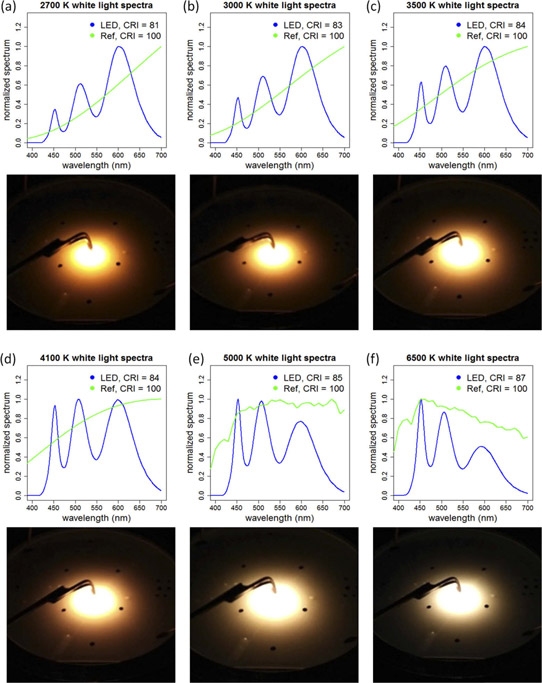News: LEDs
20 February 2020
Monolithic indium gallium nitride white light-emitting diode
US-based Ostendo Technologies Inc has demonstrated the color rendering index (CRI) capabilities of its monolithic color-tunable light-emitting diodes (LEDs) across a range of correlated color temperatures (CCTs) [Hussein S. El-Ghoroury et al, Optics Express, vol.28, p1206, 2020].
The devices consist of three sets of indium gallium nitride (InGaN) quantum wells (QWs) that emit at different wavelengths (460-650nm) according to the injected current. The different QW layers are separated by carrier-blocking regions of aluminium gallium nitride (AlGaN). The barriers are tailored by AlGaN composition, thickness and dopant concentration to guide carriers into targeted QWs, producing specific wavelengths at a given bias.
White light is generated using pulses of current injection at different levels to give various spectral balances. The ability to change the CCT is seen as advantageous for its effect on human circadian rhythms, mood and health. ‘Cool’ bright light in the 4000-6000K range is better at keeping people awake, while dimmer ‘warm’ light, at 3000K, is better for relaxation and preparing for sleep.

Figure 1: (a) Simplified cross-sectional view of monolithic color-tunable InGaN-based LED structure and (b) emission from 5mA to 350mA injection current.
The epitaxial structure (Figure 1) was grown using metal-organic chemical vapor deposition (MOCVD) – the top-most p-type magnesium-doped layers were activated by in-situ annealing in the reaction chamber.
The devices were tested on-wafer with contacts created through pressing an indium ball on the p-GaN surface and on a scribed region exposing the buried n-type material. The researchers comment: “For production purposes, transparent p-contacts like annealed [nickel/gold] Ni/Au or [indium tin oxide] ITO must be used for p-GaN and [titanium/aluminium] Ti/Al or Ti/Au should be used for n-GaN contacts to improve the contact resistivity.”
The drive set-up consisted of two-step pulse generators, an operational amplifier-based summing network, and a voltage-to-current converter, based again on op-amps and a bipolar transistor. The circuit targeted fast response and large current handling.
The researchers used manual fine-tuning of the pulse circuit, making it difficult to obtain spectra at the exact color coordinates. The team believes that this would be easy for a computer-controlled feedback system.
The LEDs produced CRI values above 80 across the range of CCTs from 2700K to 6500K (Figure 2). At the highest CCT the CRI was 87. The team suggests that improved CCT would result from “additional spectral emission peaks to increase the range and overlap in the spectral mixture”.

Figure 2: Light spectra (top) and photographic capture (bottom) of pulsed color-tunable emission at color temperatures of (a) 2700K, (b) 3000K, (c) 3500K, (d) 4100K, (e) 5000K and (f) 6500K.
Simulations of a structure with four emission peaks and driven by a three-step pulse set-up indicate that CRIs above 90 (and up to 95.4 at 4100K CCT) would be possible. The extra peak would come from an extra red emission from low (~625nm wavelength) and medium (~585nm) current injections, enhancing spectral coverage in the long-wavelength range. The two red peaks arise from significant blue-shift effects at the higher injection current.
The team comments: “The spectral content of the blue and green QW emissions is similar to those shown in the two-step pulse design due to the minimal blue-shift of the blue and green QW emission. By optimizing the blue and green QW growth parameters, the spectral coverage in the short-wavelength range can be enhanced and thus further improvement of CRI is possible.”
The use of such a monolithic chip would reduce material, complexity and packaging costs, compared with RGB designs based on separate chips emitting single colors or devices with filters.
InGaN white LEDs InGaN AlGaN White LEDs MOCVD
https://doi.org/10.1364/OE.375320
The author Mike Cooke is a freelance technology journalist who has worked in the semiconductor and advanced technology sectors since 1997.







